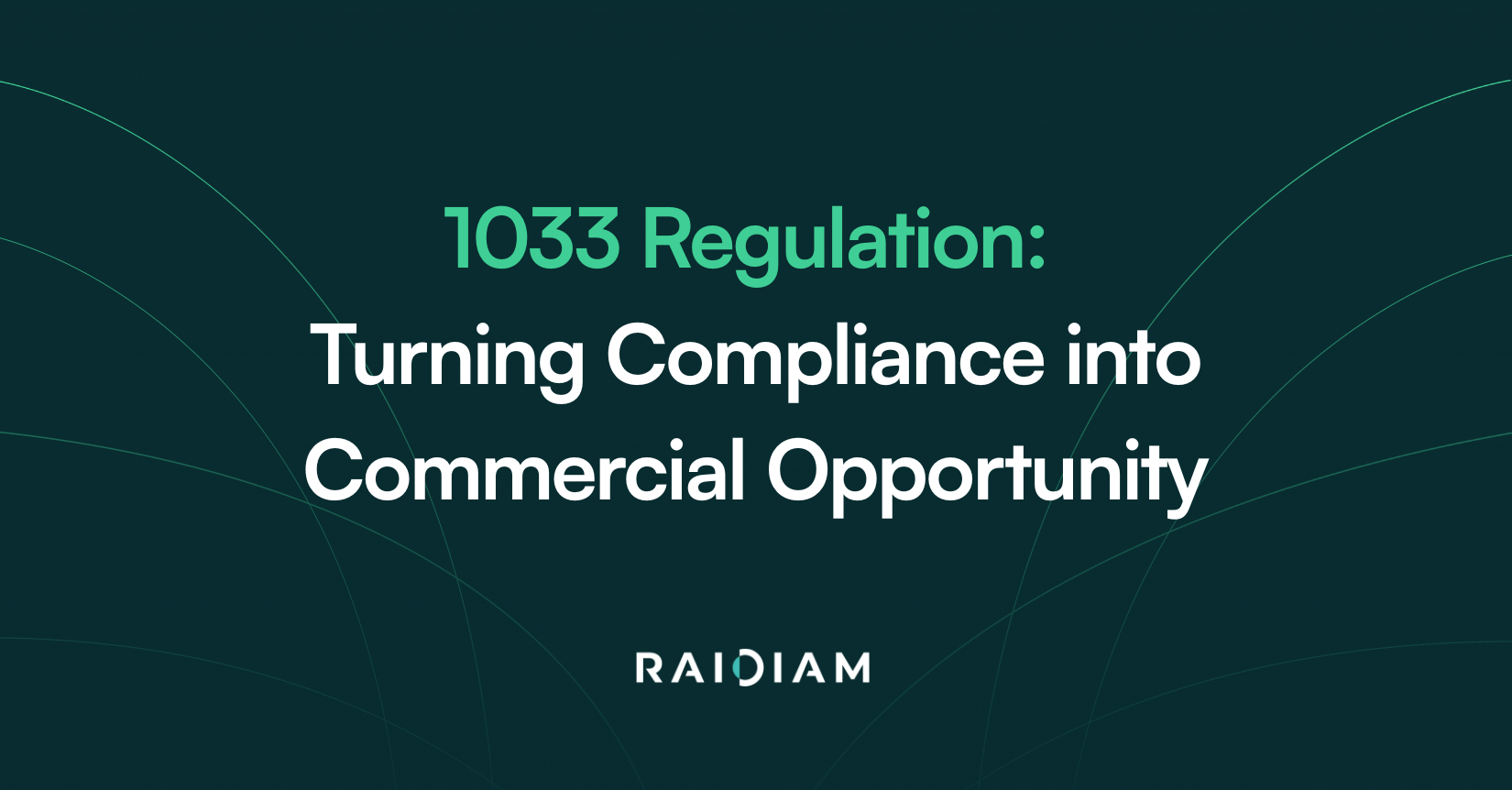
The Consumer Financial Protection Bureau’s (CFPB) Section 1033 isn’t just a regulatory hurdle—it’s a springboard for innovation. By mandating secure, standardised API access to consumer financial data, the rule unlocks opportunities for financial institutions and fintechs to monetize new services, deepen customer relationships, and redefine their role in an open finance ecosystem. Below we explore how organisations can transform compliance into commercial advantage, with a focus on payment initiation and other high-value use cases, while leveraging platforms like Raidiam Connect to streamline technical and operational complexity.
The 1033 Commercial Imperative
Section 1033 compels financial institutions to provide third parties with API access to consumer-permissioned data. While compliance is mandatory, forward-thinking organisations recognise three strategic opportunities:
Monetizing Data-Enabled Services
APIs underpin services like payment initiation, credit risk assessment, and personalised financial management. By exposing APIs commercially, banks can charge for premium data access or transaction fees. For example, a payment initiation API could enable seamless bill payments directly from a user’s account, bypassing card networks and their interchange fees.
Embedding Finance into Everyday Experiences
APIs allow non-financial brands to embed banking services into their platforms. A retailer could offer instant financing at checkout using a 1033-compliant credit decisioning API, with the bank earning revenue through white-label partnerships.
Strengthening Customer Retention
By becoming the data hub for a consumer’s financial life—via tools like consolidated financial dashboards or automated savings algorithms—institutions increase stickiness and cross-selling opportunities.
Critically, these opportunities depend on a secure, scalable API architecture that balances accessibility with compliance.
Building a Commercial API Strategy
Step 1: Identify High-Value Use Cases
Not all APIs are created equal. Prioritise services that align with market demand:
- Payment Initiation APIs: Enable direct account-to-account (A2A) payments, reducing reliance on cards and lowering transaction costs.
- Credit Decisioning APIs: Provide real-time income verification for lenders, leveraging open banking data.
- Financial Health Dashboards: Aggregate data across institutions to offer personalised insights.
Raidiam Connect’s ecosystem directory simplifies API discovery for partners, accelerating adoption.
Step 2: Design for Developer Experience
Third-party developers drive API consumption. Ensure your platform offers:
- Comprehensive Documentation: Clear guidelines for authentication, rate limits, and error handling.
- Sandbox Environments: Allow testing without production access, reducing integration friction.
- Self-Service Onboarding: Let partners register, manage credentials, and monitor usage autonomously.
Raidiam Connect’s self-service portal automates credential issuance and certificate rotation, reducing engineering overhead.
Step 3: Implement Monetization Models
Monetization strategies vary by use case:
| Model | Example |
| Pay-per-call | Charge $0.01 per payment API call |
| Subscription Tier | Premium data access for $500/month |
| Revenue sharing | Split interchange savings with partners |
Raidiam’s usage analytics provide granular insights into API consumption, enabling dynamic pricing.
The Technical Foundation: Raidiam Connect’s Role
A commercial API strategy falters without robust infrastructure. Raidiam Connect addresses four critical challenges:
Secure Participant Onboarding
Raidiam’s trust anchor framework validates third parties before granting API access. Its integration with Know Your Business (KYB) providers ensures only authorised entities participate, mitigating fraud risk.
Financial-Grade Security
Traditional API keys are replaced with certificate-based authentication, ensuring non-repudiation and aligning with standards like FAPI 2.0. Mutual TLS (mTLS) encrypts data in transit, while Raidiam’s centralised credential management enables automatic certificate rotation.
Scalable Ecosystem Governance
Managing hundreds of third-party integrations is complex. Raidiam’s unified directory tracks all participants, their credentials, and API entitlements. For example, Brazil’s Open Banking ecosystem uses Raidiam to manage 1,000+ institutions and 3.5 billion monthly API calls.
Compliance Automation
Section 1033 mandates audit trails, consent management, and data minimisation. Raidiam’s platform logs every API interaction, while its application dashboard lets administrators revoke access in real time.
→ Download Now: CFPB Rule 1033: The Insider Guide to Navigating API Security and Client Onboarding in Open Banking
Case Study: Monetizing Payment Initiation
Consider a regional bank launching a payment initiation API:
- Partner Onboarding: Merchants self-register via Raidiam’s portal, receiving credentials in minutes.
- Integration: Developers use sandbox APIs to test A2A payments, reducing go-live time.
- Launch: Merchants trigger payments via API, paying $0.005 per transaction.
- Upsell: The bank offers fraud detection APIs at a premium, leveraging the same infrastructure.
Within six months, the bank processes 10 million payments monthly, generating $50,000 in revenue while saving $200,000 in card interchange fees.
Overcoming Commercial Challenges with 1033 Regulation
-
Balancing Openness and Control
APIs expose institutions to cybersecurity risks. An API firewall can inspect payloads for anomalies, blocking malicious requests without impacting latency. -
Managing Ecosystem Complexity
Diverse third parties require flexible access policies. Raidiam’s role-based access control (RBAC) ensures partners only access approved endpoints—e.g., a fintech might query balances but not initiate payments. -
Navigating Regulatory Uncertainty
With 1033 regulation’s final rules pending, Raidiam’s compliance dashboard tracks regulatory changes, automatically updating API policies to maintain adherence.
Conclusion: From 1033 Regulation Compliance to Revenue
Section 1033 regulation isn’t the end of traditional banking—it’s the beginning of banking as a platform. By combining compliant API architectures with Raidiam Connect’s ecosystem tools, institutions can:
-
Reduce costs via automated onboarding and security.
-
Unlock revenue through premium APIs and embedded finance.
-
Future-proof their infrastructure against regulatory shifts.
The winners in the 1033 regulation era won’t just comply; they’ll commercialize.
Want to Dive Deeper into 1033 Compliance and API Strategy?
If this article sparked ideas for your organization’s 1033 regulation strategy, you’ll want to explore our full guide: “CFPB Rule 1033: The Insider Guide to Navigating API Security and Client Onboarding in Open Banking”.
Inside, you’ll find a detailed breakdown of the compliance landscape—plus actionable frameworks to help your team implement:
-
Secure, standards-based API infrastructure
-
Streamlined third-party onboarding using trust frameworks
-
Consent management systems that meet regulatory expectations
-
Real-world implementation tips to reduce complexity and accelerate timelines
Whether you’re just starting your 1033 journey or refining your platform for commercial use cases, this guide provides the technical and strategic insights you need.
Click the button below to download the full guide now and turn compliance into your next competitive advantage.


